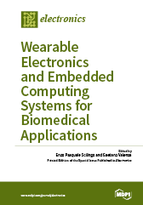Wearable Electronics and Embedded Computing Systems for Biomedical Applications
A special issue of Electronics (ISSN 2079-9292). This special issue belongs to the section "Bioelectronics".
Deadline for manuscript submissions: closed (18 June 2016) | Viewed by 135663
Special Issue Editors
Interests: wearable monitoring systems; heart rate variability; human–computer interfaces; biomedical and biomechanical signal processing; modeling; control and instrumentation; autonomic nervous system
Special Issues, Collections and Topics in MDPI journals
Interests: wearable monitoring systems; heart rate variability; nonlinear analysis; Autonomic Nervous Systems; biomedical signal processing
Special Issue Information
Dear Colleagues,
Wearable electronics and embedded computing systems have been gaining a great deal of interest over the last two decades in research and commercial fields, with a special focus on biomedical applications. The key benefits introduced by these systems include their small size, lightweight, low-power consumption, and, of course, wearability. Major human-centered applications are related to medicine enabling outpatient care and enhancing the quality of life for chronic disease patients, maybe preventing unnecessary hospitalizations. These technological avenues can indeed be cost effective and provide the doctors with more accurate and reliable data.
Exemplary engineering contribution has been focusing on developing innovative sensing platforms adaptable to different environments and user needs, smart textile technology, miniaturized electronics and sensors, energy harvesting, wireless body area networks, and so on. This has provided the possibility of gathering information in several scenarios, such as during daily activities or sleep, during specific tasks, at home, in the lab, and in the clinic, in the form of physiological signals.
We invite researchers to submit cutting-edge research articles, as well as reviews and tutorials, describing and assessing wearable devices, or proposing novel wearable sensors, computational efficient algorithms for physiological signal processing through embedded computing, collection of environmental/behavioral/psychological data, data fusion, detection and quantification of symptoms, decision support for the medical doctors, and communication of the patient with the doctor.
Potential topics include, but are not limited to:
- Innovative wearable sensing platforms and body area networks
- Smart textile technology
- Wearable systems in healthcare
- Continuous sleep monitor and evaluation
- Embedded signal processing
- Computationally efficient nonlinear digital signal processing
- Data fusion for embedded computing systems
- Smart telemonitoring systems
- Heart rate monitoring and related embedded computing
- Wearable biomedical electronics, computer and information technology
- Wireless and mobile communications in biomedical systems
Prof. Dr. Enzo Pasquale Scilingo
Dr. Gaetano Valenza
Guest Editors
Manuscript Submission Information
Manuscripts should be submitted online at www.mdpi.com by registering and logging in to this website. Once you are registered, click here to go to the submission form. Manuscripts can be submitted until the deadline. All submissions that pass pre-check are peer-reviewed. Accepted papers will be published continuously in the journal (as soon as accepted) and will be listed together on the special issue website. Research articles, review articles as well as short communications are invited. For planned papers, a title and short abstract (about 100 words) can be sent to the Editorial Office for announcement on this website.
Submitted manuscripts should not have been published previously, nor be under consideration for publication elsewhere (except conference proceedings papers). All manuscripts are thoroughly refereed through a single-blind peer-review process. A guide for authors and other relevant information for submission of manuscripts is available on the Instructions for Authors page. Electronics is an international peer-reviewed open access semimonthly journal published by MDPI.
Please visit the Instructions for Authors page before submitting a manuscript. The Article Processing Charge (APC) for publication in this open access journal is 2400 CHF (Swiss Francs). Submitted papers should be well formatted and use good English. Authors may use MDPI's English editing service prior to publication or during author revisions.







